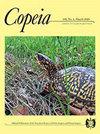阿根廷中部最高山区特有蜥蜴阿查利拟趾蜥精子参数的研究
IF 2.6
Q2 Agricultural and Biological Sciences
引用次数: 1
摘要
生殖生理受到环境压力的影响,尤其是生活在恶劣气候条件下的体外热物种。研究男性表现出精液可用性的时间段及其精子特征是评估男性生育潜力的有力工具,因为精子大小和精子速度已被认为是受精成功的决定因素。阿氏原蜥是一种原产于阿根廷中部最高山区的蜥蜴,具有季节性活动模式。在这里,我们研究了雄性在活跃季节拥有精子的时间段,并根据雄性和精液中的精子形态和动态特征来表征精子。雄性的精液中只有在活跃季节的春季才会有精子,这表明生殖活动仅限于这个时候。阿氏原蠊精子在雄性和射精过程中表现出精子特征的特异性差异,表明雄性之间的生殖潜力不同。由于该物种只占据山脉的最高区域,被归类为易危物种,因此有关繁殖和精子生理学的基本信息可能对潜在的种群保护策略有用。本文章由计算机程序翻译,如有差异,请以英文原文为准。
Sperm Parameters in Pristidactylus achalensis (Squamata: Leiosauridae), a Lizard Endemic to the Highest Mountain Areas in Central Argentina
Reproductive physiology is influenced by environmental pressures, particularly in ectothermic species living in harsh climatic conditions. Studying the period of time in which males exhibit semen availability and their sperm traits constitutes a powerful tool to evaluate the fertility potential of males because sperm size and sperm velocity have been proposed as determinants in fertilization success. Pristidactylus achalensis is a lizard endemic to the highest mountain areas in Central Argentina and shows a pattern of seasonal activity. Here, we study the period of time when males possess sperm during the active season and characterize the spermatozoa based on sperm morphometric and dynamic traits among males and within ejaculate. Males possess sperm in their ejaculates only during the spring months of the active season, suggesting that reproductive activity is restricted to this time. Spermatozoa of Pristidactylus achalensis show intra-specific variation in sperm traits among males and within ejaculate, suggesting different reproductive potential among males. Since this species only occupies the highest areas of the mountains and is categorized as vulnerable, basic information about reproduction and sperm physiology could be useful for potential population conservation strategies.
求助全文
通过发布文献求助,成功后即可免费获取论文全文。
去求助
来源期刊

Copeia
生物-动物学
CiteScore
2.10
自引率
0.00%
发文量
0
审稿时长
6-12 weeks
期刊介绍:
Founded in 1913, Copeia is a highly respected international journal dedicated to the publication of high quality, original research papers on the behavior, conservation, ecology, genetics, morphology, evolution, physiology, systematics and taxonomy of extant and extinct fishes, amphibians, and reptiles. Copeia is published electronically and is available through BioOne. Articles are published online first, and print issues appear four times per year. In addition to research articles, Copeia publishes invited review papers, book reviews, and compiles virtual issues on topics of interest drawn from papers previously published in the journal.
 求助内容:
求助内容: 应助结果提醒方式:
应助结果提醒方式:


